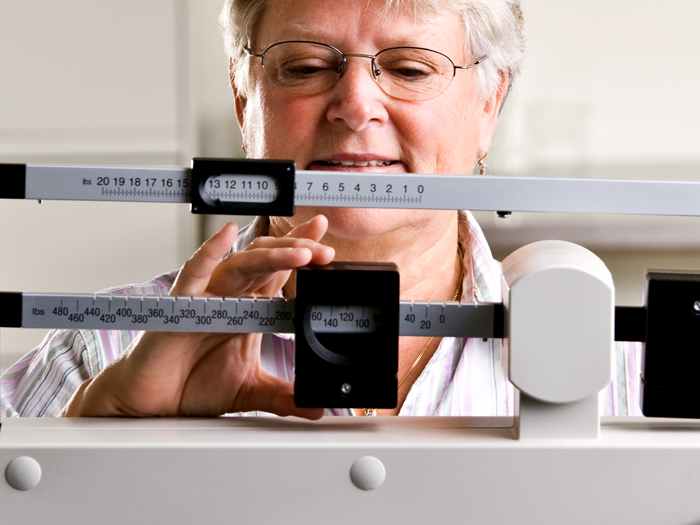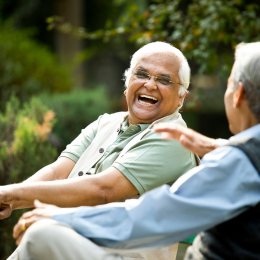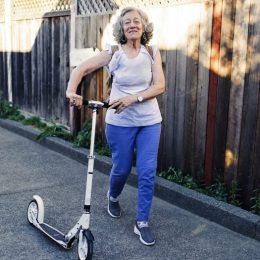7 Common Weight Loss Mistakes People Over 60 Make
Are you sabotaging yourself without even knowing it? Here’s how to find out—and start getting results.

It’s rare to hear anyone, at any age, brag about how easy it is to maintain their ideal size. But as you get older, it might seem like the struggle to stay slim is even greater than it used to be. You’re not imagining it.
Many older adults find that moving around becomes more difficult, so you end up burning fewer calories throughout the day. Meanwhile, muscle mass typically declines with age. “Your body burns fewer calories while at rest, but your appetite hasn’t necessarily decreased,” says Lyssie Lakatos, R.D.N., a dietitian, personal trainer, and coauthor of The Nutrition Twins’ Veggie Cure. The result is weight gain, which can raise your risk of conditions like diabetes and heart disease.
Losing excess pounds can make you feel better and protect your health—but what if you’ve already tried and nothing seems to work? You could be sabotaging yourself without even knowing it. Here are seven common obstacles on the path to weight loss success—and how to jump right over them.
Weight Loss Mistake #1: It Hurts to Move, So You Don’t
Maybe you have arthritis in your knee, a bad back, or are recovering from some sort of surgery. While you definitely need to get clearance from your doctor first, there’s a pretty good chance that you can and should still be exercising. While no one is suggesting you run a marathon, there are lots of low-impact activities that are probably safe for you, like walking, water aerobics, yoga, and tai chi. “Maintaining strength and flexibility is key to staying mobile—and feeling better and younger,” Lakatos says.
In fact, the Arthritis Foundation says that “exercise is considered the most effective non-drug treatment for reducing pain and improving movement.” A combo of flexibility, aerobic, and strength training moves is best. Aerobic or cardio exercise helps you burn calories, and strength or resistance training builds muscle mass, which kicks up your metabolism (more on this later). Major bonus: As the weight starts to come off, it will take pressure off aching joints. Get moving safely with this guide to exercising with arthritis.
When pain is a problem, you’ll also want to pay attention to your diet and eat anti-inflammatory foods, Lakatos says. That should help you lose weight and reduce inflammation throughout your body, including wherever it is that you hurt. Aim to eat lots of fresh fruits and veggies, fatty fish like salmon, beans, and whole grains. Limit processed foods and added sugar, which have empty calories—meaning they are high in calories but low in nutrients.
If you’re concerned about inflammation, you may want to cut back on vegetable oils since they’re high in omega-6 fats, which can produce inflammatory chemicals, Lakatos says. Olive oil, which has heart-healthy fats, may be a better option. Whether you choose vegetable or olive oil, stick to healthy portions: about 1 teaspoon per serving.
Weight Loss Mistake #2: Your Diet Is Stuck in 1985
The science on what to eat to lose weight in a healthy, sustainable way has shifted a lot over the years. “A lot of people in older generations still think coffee and OJ for breakfast means you’re on a good diet,” says Cris Dobrosielski, a spokesperson for the American Council on Exercise and author of Going the Distance: The Three Essential Elements of Optimal Lifelong Fitness and Injury Prevention. “But it’s just sugar, and you need protein and fiber.”
If you’re not sure what to eat, it’s time to do a little homework. One good resource is MyPlate for Older Adults. Created by Tufts University in conjunction with AARP, it breaks down the latest nutrition guidelines on what a balanced diet should look like for older adults, says Jeri W. Nieves, Ph.D., an associate professor of clinical epidemiology and nutrition at Columbia University Mailman School of Public Health.
Hint: Aim to fill half your plate at every meal with fruits and veggies, then add some whole grains, lean protein, and a little dairy to keep your bones strong. Controlling portions is also crucial. “The correct serving size of protein is about a deck of cards, but many people will eat several decks of cards,” Nieves says. For more tips, check out our guide to the latest food guidelines for older adults.
Weight Loss Mistake #3: You Focus on Cutting, Not Adding
Sure, you can lose weight by eating nothing but toast and tea, but the goal is to become fit and strong—not weak and frail. “You need good nutrients to preserve muscle and bone mass,” Nieves says. “I’m worried that many people don’t consume enough calcium, protein, and vitamin D, especially when trying to lose weight.”
Nieves also warns that most older adults don’t get nearly enough fiber or potassium, an important mineral found in potatoes, spinach, and, of course, bananas.
Her advice: Think about what you might be lacking in your diet, consulting your doctor or a dietitian if you’re unsure or managing a chronic condition. Then aim to eat more of those foods. Once you do that, you should naturally have less room for the not-so-healthy foods—like refined carbs, which have less fiber than whole grains—that might be contributing to weight gain. In other words, be choosy. “It’s not just about reducing your intake,” Nieves says.
Weight Loss Mistake #4: You’re Afraid of Exercise or Don’t Do It Right
Maybe you’re clueless about how to get started, worried you’ll hurt yourself, or still doing situps the way you did back in high school. First, when in doubt, know that some movement—any kind—is better than nothing, Dobrosielski says.
That said, if you’re serious about losing weight and staying fit for the long haul, it’s best to develop a well-rounded routine that incorporates flexibility, aerobic or cardio, and strength or resistance exercises. Strength training is especially important as you get older. “Remember, muscle mass fuels your metabolism so that your body burns more calories,” Lakatos says.
Trying out a few different SilverSneakers classes is one good way to cover all these bases. If you need extra help, consider booking an assessment or tutorial with a certified fitness professional. An expert can get you on the fast track to weight loss and explain how to do it safely. One or two sessions might be enough to learn the ropes so you can fly solo from there, Dobrosielski says.
Weight Loss Mistake #5: You Never Snack
It might seem counterintuitive, but eating more frequently usually translates to eating less overall, Dobrosielski says. “I often ask clients who are older adults to tell me about the snacks they eat, and they say ‘I don’t eat any snacks!’ Well, I’m going to advocate that you do!”
The problem, he explains, is that people who avoid eating between meals often end up overdoing it when they finally chow down. Ideally, you shouldn’t be going more than three to four hours without food. The goal is to keep your blood sugar stable and your appetite in check.
That said, you’re not going to lose weight if you’re snacking on chips and candy all day. Stock up on a few healthy nibbles to keep you fueled. Dobrosielski suggests a small handful of almonds with an apple, some low-fat Greek yogurt with berries, or a few lean slices of deli meat wrapped in lettuce. Or try one of these best snacks for active older adults.
Subscribe to our newsletter
It's quick and easy. You could be one of the 13 million people who are eligible.
Already a member? Click to discover our 15,000+ participating locations.
Follow Us
Weight Loss Mistake #6: You’re Tormented by Your Scale
You probably wouldn’t be reading this if you didn’t want to lose weight. But should you even lose weight? About 41 percent of the 60+ crowd are considered obese, so the answer may very well be yes. But it’s still a topic that’s worth discussing with your doctor.
Body mass index (BMI)—a number based on your height and weight—is often cited as a good way to quickly figure out if you have excess pounds to shed. But Nieves points out that it could be falsely elevated in people who have lost a few inches due to osteoporosis, because it’s impossible for them to stand up straight.
Another issue is that some people think they ought to be “skinny,” but being too thin—especially as you get older—is also potentially dangerous. While you may very well have pounds of fat to lose, in some cases it’s better to keep the scale steady or even put on a little weight if it means adding lean muscle mass with strength training, Dobrosielski says. Strong, not skeletal, should be your goal.
If you’re managing diabetes, heart disease, or another chronic condition, talk to your doctor about your healthiest weight. A healthy weight can reduce symptoms and lower your risk of health complications.
Weight Loss Mistake #7: You Rely on “Health Foods” and Your Own Willpower
Being on a retiree’s budget shouldn’t constrain your weight loss efforts in any way, Dobrosielski says. “You don’t need to buy expensive powders or shop at specialty stores,” he says. “You can go to the local supermarket and do delightfully well on a relatively low budget—as long as you do a good job of reading labels.” Look for options with less fat, sodium, and sugar. Choose options with more fiber, protein, and other nutrients.
The most important thing you can do is actually free but not necessarily easy: It’s breaking some long-ingrained bad habits and replacing them with better ones. “Establishing good habits is far more powerful than relying on willpower,” Dobrosielski says.
His advice is to start small. Try preparing the same healthy breakfast every morning or taking a walk at the same time every day until it starts to feel almost automatic. Then build from there.
Take Your Favorite SilverSneakers Classes Online!
SilverSneakers members can access live fitness classes and wellness workshops through SilverSneakers LIVE. See the latest schedule and RSVP for classes here.
Not a member? If you have a Medicare Plan, it may include SilverSneakers—at no additional cost. Check your eligibility instantly here.





